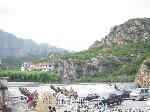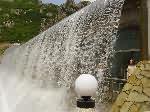- Getting around Lijiang. Dont stay in the Old Towns more than 2 days, there is nothing to do. KRISS Oct 9, 2013 05:46
- 2013 Beijing Temple Fair BENNYLAU Feb 26, 2013 03:29
- Malaysian traveling from KUL - LAX vis Shanghai PVG ZATI_DY Jan 3, 2013 20:15
Guilin in Miniature - Bingyugou
- Views: 6084
- |Vote: 1 0
- |Add to Favorites
- |Recommend to Friends
Zhuanghe in the Summer Heat
Zhuanghe isn’t one of China’s most renowned destinations and rarely finds its way onto any traveller’s itinerary. A typical smaller-sized city in Dalian Prefecture, Liaoning, it’s a small collection of apartment buildings in an otherwise sprawling farmland. It does, however, hold one quite exceptional scenic resort – not far away from the city is a small gorge hidden away in the mountains, where the karst rock rises in the same kinds of strange columns travellers might expect to see in Guilin. In fact, the gorge has often been labelled as the ‘Little Guilin’, and in recent years has been developed into a smart and attractive getaway for local Dalianese and the odd visitor from elsewhere in the country or abroad. If you’re in the North, it might also be seen as a relatively inexpensive way to enjoy Guilin-style scenery without having to trek all the way down to the bottom of China.
I visited Bingyugou in the late summer, trying to get away from the swelter of the big city. In the sweaty summer weather, the Liaodong Peninsula enjoys a cooler climate due to frequent gentle sea breezes, but riding in hot, crowded buses is still quite uncomfortable. There’s a train that stops in Zhuanghe, but the last 40km trip to the gorge over bumpy old roads is most usually travelled by cheap minivan, and there’s little point in opening the windows, as under the bright sunshine, it just doesn’t get any cooler. The scenery more than makes up for it, however – Liaoning’s farmlands are typically bare and dry, but throughout greater Dalian, the countryside is lush and the mountains are plentiful and rather spectacular, craggy peaks with smooth rock faces, spread over with wild brush like a syrup.
The minivan stops at an unlikely carpark a short walk away from the entrance gates and ticket booths – which charge a cool 100 yuan for entry to the resort – and close to a few reasonably priced accommodation options. You can stay in the gorge itself, in one of the nicely-decorated but poorly-equipped lodges on the lake front – or in one of these hostels outside the park. Some of the rooms available are in local ‘farmstays’, where you can enjoy a night of approximately genuine Liaoning country living. Generally however, travellers prefer to stay in Bingyugou proper for the day or two they’ll spend here – if only for the evening functions, dances and performances held nightly by the water.
A bright, straight, man-made waterfall stands just beyond the entrance gate – just a short drop in the river, but pretty nonetheless – and just past that is the quay where small passenger boats decorated with dragon heads and a carrying capacity of around 20 tourists each will take you on the first serene river sailing through the surrounding mountains and to the centre of the park itself. It’s a wonderful introduction to the mood of Bingyugou, which markets itself as a primitive and natural location with peaceful and quiet surrounds, embellished with touches of traditional Chinese culture. The description is fairly accurate, and as my boat sailed past a few massive shards of mountain rock, I had to admit to being rather impressed – but there is one aspect that is missing from the tourist brochures. This is a holiday spot for the wealthy – Dalian city is quite well developed economically – and so in the midst of the peace and quiet are some quite noisy posh restaurants and plush hotels. If you’re looking for a fun holiday resort in a beautiful setting, than it’s ideal – if you’re not, there’s still plenty of places to escape to and you needn’t be too dismayed by the expensive look of the accommodation complex.
The Gorge
The boat continued to float peacefully down the river until we reached the main park accessway at Zhongliu Dizhu. A winding pathway takes visitors past a shallow stepping-stone crossway and into the heart of Bingyugou – clean, bright and sparkling with river light. It’s an attractive park with some very Chinese flourishes – little pagodas to shade from the sun, discrete little water fountains and the odd sculpture or stone marker with finely engraved calligraphy – but overwhelmingly, the park is a natural wonder, as the calm river waters flow about the mountainsides and quiet bush. Nicely cut lawns and well-placed willows add a refined touch to the intensely green foliage and pure mountain streams. I walked through and across the main causeway bridge to the hotel area, and found a room to my liking without too much difficulty. I had the whole weekend to explore, and so started by merely walking calmly around the grounds. Mountain peaks were all around, and on the crests of some of them, small, pretty pavilions marked lookouts accessible to those limber enough to make the climb.
There’s a good walkway around the river detailed on the tourist map of the area, and so I decided to follow it and check out the various attractions listed along the way. I headed back for the stepping stones and carefully crossed to the other side of the river – I noticed that many of the park’s visitors were spending the afternoon instead floating lazily on the waters in private ‘duckboats’, lazily wiling away the day in the sunshine.
On the other side is a short climb, which offers a nice view of the entire complex – the lodges, from above, looked like little Swedish skiing chateaux. You can also see the iconic rock formation shown in the parks promotional photographs – Ming Yue Jian.
Over the crest and back at ground level is a small Mongolian encampment with real Yurts and horserides. It was cute, but a little out of place – coming off as something of a gimmick. The Mongolians were a little upset when I told them I didn’t want a horse ride too. I walked on and went a fair way along the river in the direction of the next scenic spot – the part of the park that’s officially known as ‘Little Guilin’. Again, it wasn’t quite what I expected – The river area around the accommodation complex was already markedly similar to Guilin, and this part of the river seemed less so – but I soon realised that ‘Little Guilin’ was merely the name of the Children’s playground area.
I went on, along a road that led away from the river and up into the mountains. The other tourists wandering around the park near me became fewer and fewer. Passing carts offered me a ride for five yuan, but I refused, thinking I could walk the distance to the temple marked on the map. I was foolish – it was a long and hot trek before I got to where I wanted to see, and it was already drawing towards night. The temple was pretty, but had the same clean, new look of all the other buildings in Bingyugou – which made it less attractive than those older temples in other parts of China.
I took the ride back to Little Guilin – hanging on for dear life as the driver sped through the dark, empty mountain roads – and then walked, in a delighted mood, back along the river to the park. At night, it was all done up like a disco, and the music pumping out over the valley was boisterous and alive.
Climb
The next day I decided to tackle a real climb – taking one of the steep routes leading back behind the valley up into the mountains. Wandering back along the river, I came to another man-made waterfall – much more impressive this time, with an underpass with windows looking out into the cascading water from underneath the fall. It was whilst watching the waterfall that I really understood both the attraction and the problem with Bingyugou – it’s precisely sculptured. I loved staying there, because it was spotless, beautiful, and relaxing – but it wasn’t the kind of beauty that you normally expect from Chinese destinations – that well-known austere and evocative bitter-sweet charm. Wandering beneath the waterfall, I got the same kind of feeling as I’d had in the temple the night before – it was lovely, but in some way mediated for me, presented on a plate rather than just left for me to see.
Getting up the mountain was a bit more authentic. The path hasn’t really been paid as much attention to as some of the other walkways around the gorge, and so it was relatively tough going, especially in the midday sun. The more I climbed, the more the thick leaves around me seemed to sweat hot air, the more colourful insects I passed by, butterflies, dragonflies, strangely beautiful spiders. The view was uncontaminated and fresh, and I couldn’t have hoped for brighter greens.
I couldn’t find my way up to one of the mountaintop pagodas, but I did get some magnificent aerial views of the valley. You might complain about Bingyugou – claim it’s commercialised, packaged for tourists, spoiled – but I couldn’t disagree more. The good people of Zhuanghe have taken a beautiful gorge in the remote wild of the province and carefully arranged some neat installations to make it comfortable for all visitors. From the top of the mountains looking over it, I was satisfied for myself that they’ve done a good job of it.






 Copyright © 1998-2025 All rights reserved.
Copyright © 1998-2025 All rights reserved.